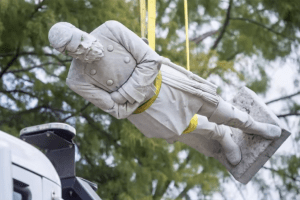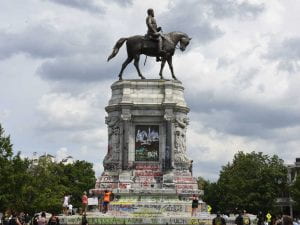This is an insight written by Stella Hudson on the recent Bahá’í Chair for the World Peace Lecture, “Reading Monuments, Marking Turf, and Embedding Memories” held on September 14, 2021.
It feels like it should be obvious, yet it has to be reiterated at every turn; history is not irrelevant. The actions, triumphs, and shames of the past have shaped the present, which in turn shapes the future. The past is not so distant, and the choices we make today will impact tomorrow in ways both predictable and totally unexpected.
Monuments are one way that a society records history. Rather than a perfect reconstruction, monuments, their placement, subjects, and framing, are representations, interpretations, and re-workings of the past. Kristen Mullen addresses this in her talk “Reading Monuments, Marking Turf, and Embedding Memories.” She points out that all of the confederate monuments still on display across America form a kind of shared secular faith, a narrative of a noble lost cause, a fight for states’ rights, and one overlooking the realities and inhumanities of slavery and the civil war.

After 99 years at the corner of Jefferson Street and Lee Avenue in downtown Lafayette, the statue of Confederate Gen. Alfred Mouton is removed. Saturday, July 17, 2021. SCOTT CLAUSE/USA TODAY NETWORK
The debate over what to do with these monuments has been making headlines. People often argue that removing them is the same as erasing history. However, the history these monuments represent is imagined, it was created deliberately by white people who wanted to maintain their power. Our society moving forward would be stronger and more equipped to address the structural racism of today if the mythological tragic southern hero narrative was seen for what it is, fiction.
The truth is that it is the presence of these monuments that erase the true history. Too many people grow up in this country learning that white people were generally nice to their slaves, that black people liked working on plantations, that the civil war was about the overbearing northern government trying to dominate and smother the superior southern culture. Everyone knows the names and faces of Robert E. Lee, Stonewall Jackson, and Nathan Bedford, yet many are shocked to learn about people like Abraham Galloway and Pauli Murray, or events as huge as the Tulsa Massacre.
Confederate monuments are not the last line of defense between an educated and uneducated public. In fact, they stand in the way of real knowledge. They allow people to comfortably reside in the narrative of northern aggression and states rights, which is much less uncomfortable than the realities of slavery and racism which run through the foundation of this country up into the present day. Many of the monuments were erected decades after the Civil War as a way to purposely glorify the past, intimidate non-white people, and declare white supremacy. Those who interpret them as accurate connections to the past are the ones who are erasing and forgetting real history.

The Lee Statue, Richmond VA. Image from https://progressive.org/latest/story-behind-lee-statue-richmond-virginia-rachleff-200707/
Is it any wonder that the idea of the tragic hero, the chivalric south, the noble rebel with a lost cause, is perpetuated? After all, everywhere you go, from parks, to town centers, to state capitals, you can look up into the bronzed face of a man, larger than life, on horseback, with his arms and eyes raised proudly and defiantly towards the sky. These monuments are objects of veneration, not shame, nostalgia, not remembrance.
At the very least these monuments should be taken down from locations of admiration. The small plaques or addendums highlighting their contentious history are a good thought, but not enough. Personally, I don’t think much would be lost if they were all removed, but I can understand the impulse against destroying them entirely. Because most of them were made after reconstruction and not during the civil war, I feel it is clear that their intention was to glorify the racist past and pronounce to black people that they would always be less than.
If we want to live in a society that does not promote those ideas then we need to lose the symbols. If they are not totally eradicated, then they should be in a museum setting like the Holocaust Museum which makes it abundantly clear that they are being displayed as a reminder of a past we never want to repeat, not a glorious one we want to remember fondly. Even institutionalizing them like that seems dangerous, however, and if removing the monuments means forgetting the falsified exalted past, then it’s a narrative best forgotten in favor of the truth.
About the Author:
 Stella Hudson is a Graduate Assistant with the Baha’i Chair for World Peace. She graduated from the College of William and Mary in 2021 with a B.A. in English. She is attending the University of Maryland and pursuing a Master’s of Library and Information Science.
Stella Hudson is a Graduate Assistant with the Baha’i Chair for World Peace. She graduated from the College of William and Mary in 2021 with a B.A. in English. She is attending the University of Maryland and pursuing a Master’s of Library and Information Science.
